From Our Archives
For other essays on this week's texts, see Dan Clendenin, Paul at Athens (2011); and Debie Thomas, Love and Obedience (2020).
For Sunday May 14, 2023
Lectionary Readings (Revised Common Lectionary, Year A)
Acts 17:22–31
Psalm 66:8–20
1 Peter 3:13–22
John 14:15–21
This Week's Essay
Back in 1987 I served three weeks as a visiting professor at the Bangui Evangelical School of Theology (BEST) in the Central African Republic. The seminary was founded in 1973 to train pastors from over twenty Francophone African countries at a graduate level. Bangui holds a special place in my heart — it was my first of what eventually became six trips to Africa.
In 2014, BEST had to close because of the chaos that had engulfed the Central African Republic. Ban Ki-moon described the C.A.R. as in "free fall." France and the UN warned of genocide. Leaders of the African Union have worried that the country could slip “into the abyss." One quarter of the population had been displaced.
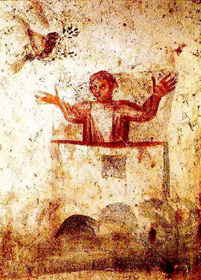 |
|
Noah and the Dove, Roman Catacomb,
2-4th century. |
Despite all that chaos and violence, the BEST campus became a safe haven for the country's displaced citizens. It became a sort of Noah's Ark for 1500 refugees, including many Muslim families.
My friend Jack Robinson explains: "Because BEST was just across the street from the telecommunications center for the country, which was heavily guarded by French troops, it did not represent an attractive target for rebel soldiers. The campus was still secure, but all the campus buildings and classrooms were full of families grateful for some kind of shelter and security in the midst of the violence in the city."
When I mentioned this story to my friend Art, he had the perfect response: "That's what our churches should be — places of refuge."
The epistle 1 Peter 3 for this week is one of the most complicated and controversial texts in the New Testament. In his commentary on 1 Peter, Martin Luther threw up his hands: “A wonderful text is this, and a more obscure passage perhaps than any other in the New Testament, so that I do not know for certainty just what Peter means.” Here is 1 Peter 3:18-22.
For Christ also died for sins once for all, the just for the unjust, so that he might bring us to God, having been put to death in the flesh, but made alive in the spirit; in which also he went and made proclamation to the spirits now in prison, who once were disobedient, when the patience of God kept waiting in the days of Noah, during the construction of the ark, in which a few, that is, eight persons, were brought safely through the water. Corresponding to that, baptism now saves you — not the removal of dirt from the flesh, but an appeal to God for a good conscience — through the resurrection of Jesus Christ.
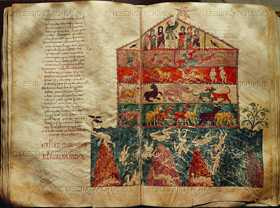 |
|
Spanish manuscript, c. 900-975.
|
Scholars debate everything about these verses — the punctuation, the pronouns, the verb tenses, the meaning of every word.
The story of Noah's Ark and the Flood has suffered from numerous tortured interpretations — as a primitive tale from a pre-historic people; a cute flannel graph for kids; an apologetic for archaeology, geology and meteorology; or an unoriginal flood story similar to epics in other religious traditions, as if the Hebraic tradition has nothing unique to say.
You can visit full-size replicas of Noah's ark in Holland and Hong Kong. Bogus pseudo-science appeals to the flood. Since the third century, explorers have tried to find the archaeological remains of the ark. There's also the cruel theology of the church fathers that insisted that just as there was no salvation outside of Noah's ark, there's no salvation outside the Christian church.
But the story has also appealed to our better angels. Consider the artistic expressions like the five that I've included with this essay — catacomb frescoes, illuminated manuscripts, massive church doors, mosaics, tapestries, and more. Huge of St. Victor (d. 1141) wrote three treatises based upon Noah's ark.
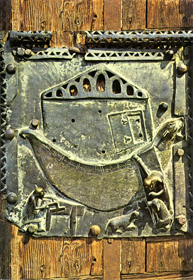 |
|
12th century bronze door, Italy.
|
In the end, and after all the complications and obfuscations, 1 Peter 3 makes a simple but profound point when it compares church baptism to Noah's ark — the church should be a place of refuge, safety, and salvation. It is a life boat. A shelter from the storm, like the seminary campus in Bangui.
Honesty requires us to acknowledge that the church has failed miserably in this regard in many times and places. We've been a place of danger, abuse and exclusion, not a place of welcome, safety and refuge. But at least we can aspire to our original charter.
Traditional church architecture has emphasized the safety provided by Noah's Ark. The main part of the church where the congregation sits is called the nave. The word "nave" comes from the Latin word "navis," meaning ship (a collection of ships is a "navy"). The church nave thus symbolizes a ship with its vaulted ceiling looking like an inverted keel. And so the church is a shelter in a storm.
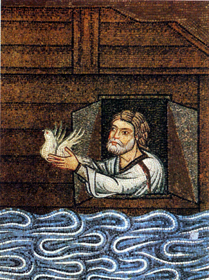 |
|
Mosaic in Basilica di San Marco,
Venice, 12th-13th century. |
In his book Whistling in the Dark: A Doubter's Dictionary (1988), Fredrick Buechner comments on the church as Noah's Ark:
In one as in the other, just about everything imaginable is aboard, the clean and the unclean both. They are all piled in together helter-skelter, the predators and the prey, the wild and the tame, the sleek and beautiful ones and the ones that are ugly as sin. There are sly young foxes and impossible old cows. There are the catty and the piggish and the peacock-proud. There are hawks and there are doves. Some are wise as owls, some silly as geese; some meek as lambs and others fire-breathing dragons. There are times when they all cackle and grunt and roar and sing together, and there are times when you could hear a pin drop. Most of them have no clear idea just where they’re supposed to be heading or how they’re supposed to get there or what they’ll find if and when they finally do, but they figure the people in charge must know and in the meanwhile sit back on their haunches and try to enjoy the ride.
It’s not all enjoyable. There’s backbiting just like everywhere else. There’s a pecking order. There’s jostling at the trough. There’s growling and grousing, bitching and whining. There are dogs in the manger and old goats and black widows. It’s a regular menagerie in there, and sometimes it smells to high Heaven like one.
But even at its worst, there’s at least one thing that makes it bearable within, and that is the storm without — the wild winds and terrible waves and in all the watery waste no help in sight.
And at its best there is, if never clear sailing, shelter from the blast, a sense of somehow heading in the right direction in spite of everything, a ship to keep afloat, and, like a beacon in the dark, the hope of finding safe harbor at last.
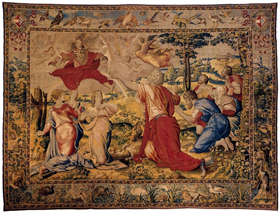 |
|
Wool and silk tapestry by Willem de Pannemaker,
1567, God's covenant with Noah. |
Thus, Jesus the redeemer effected a great reversal. Whereas the waters of the Flood brought death and destruction, the waters of church baptism bring new life, protection from danger, and a shelter in the storm.
After God judged the earth with a flood, He established a covenant or agreement with Noah. "Never again" — a phrase that's repeated five times, God promised, would He judge humanity like He had, "even though every inclination of his heart is evil from childhood" (Genesis 8:21). The scale and scope of the Noahic covenant is as comprehensive and universal as the waters of the flood. God's covenant extended not only to Noah, his family, and his descendants, but to "all life on earth," "all living creatures of every kind," and even more remarkably to "the earth" itself (Genesis 9:13, 15, 17). The protection of God is for all people everywhere, not just a select few, and it is the mission of the church to be His safe haven.
Weekly Prayer
Prayer of Mother Teresa and Brother Roger
Oh God, the father of all,
you ask every one of us to spread
Love where the poor are humiliated,
Joy where the Church is brought low,
And reconciliation where people are divided. . .
Father against son, mother against daughter,
Husband against wife,
Believers against those who cannot believe,
Christians against their unloved fellow Christians.A prayer jointly written by Mother Teresa and Brother Roger of Taize. From Kathryn Spink, Mother Teresa: A Complete Authorized Biography (New York: HarperCollins, 1997), pp. 152-153.
Dan Clendenin: dan@journeywithjesus.net
Image credits: (1) Wikipedia.org; (2) ShelleySDavies.com; (3) ShelleySDavies.com; (4) Wikipedia.org; (5) HealOurChurch.wordpress.com.





